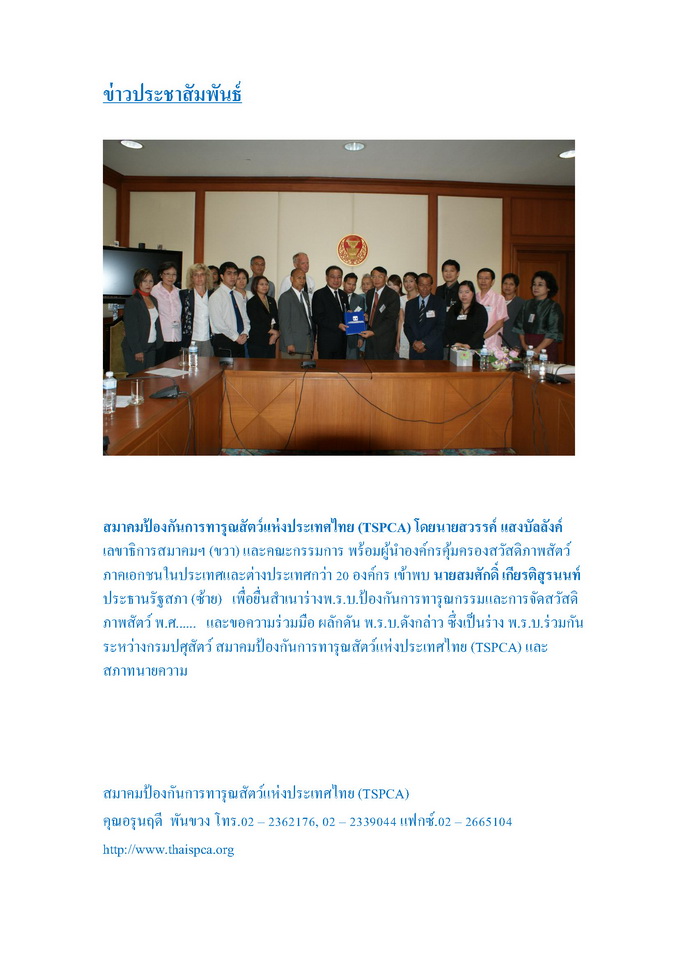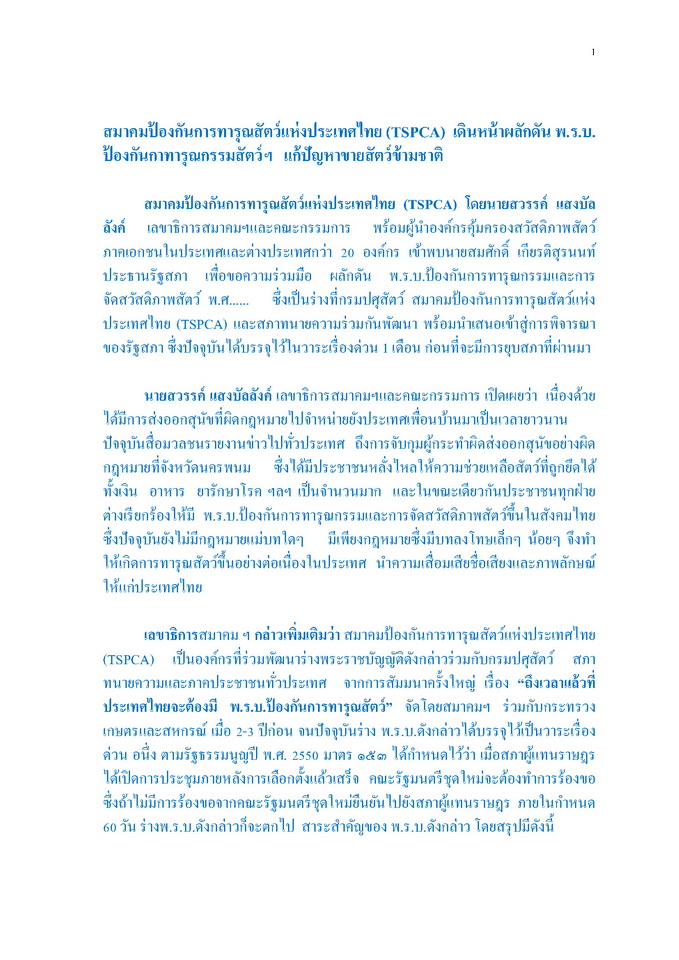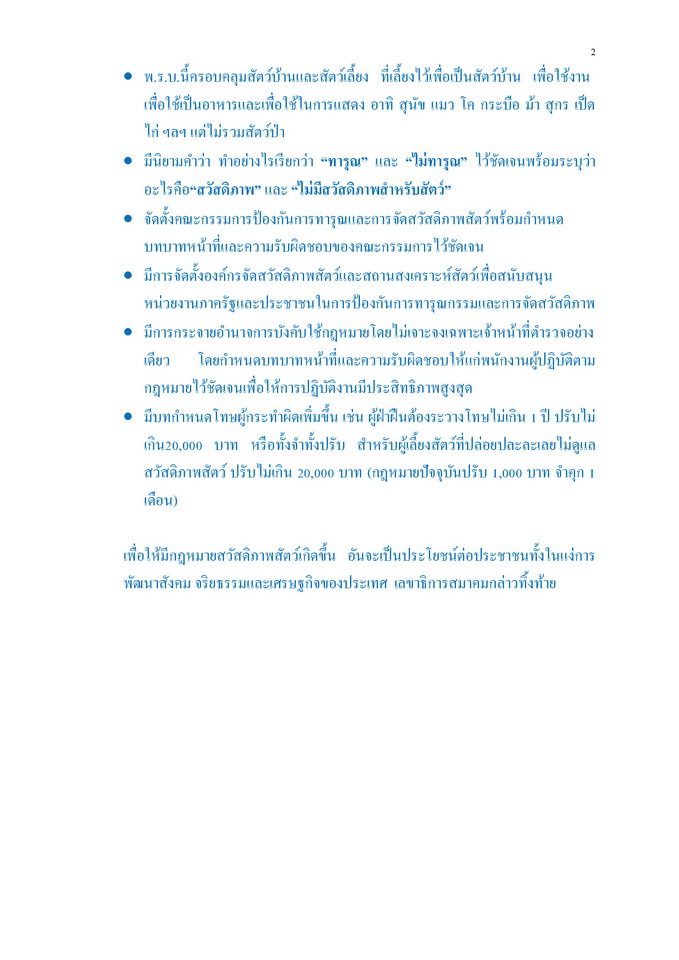ร่าง พ.ร.บ.ป้องกันการทารุณกรรมและจัดสวัสดิภาพสัตว์ | |
|
เกษตรฯ ชงกฎหมายฟันคนทารุณสัตว์โทษทั้งจำ-ปรับ  http://m.thairath.co.th/content/pol/232528 เกษตรฯ ชง ร่าง พ.ร.บ.ป้องกันการทารุณกรรมและการจัดสวัสดิภาพสัตว์ พ.ศ. .... เพื่อคุ้มครองไม่ให้สัตว์ถูกกระทำทารุณกรรม มีโทษจำคุก 1 ปี ปรับ 2 หมื่นบาท เมื่อวันที่ 22 ม.ค. มีรายงานว่า ในการประชุม ครม.วันที่ 24 ม.ค.นี้ กระทรวงเกษตรและสหกรณ์ ขอความเห็นชอบ ร่าง พ.ร.บ.ป้องกันการทารุณกรรมและการจัดสวัสดิภาพสัตว์ พ.ศ. .... เพื่อคุ้มครองไม่ให้สัตว์ถูกกระทำทารุณกรรม และเจ้าของสัตว์ซึ่งนำมาเลี้ยงจะต้องจัดสวัสดิภาพให้เหมาะสมตามประเภท และชนิดของสัตว์ ทั้งในระหว่างการเลี้ยงดู การขนส่ง การนำไปใช้งาน หรือในการแสดง โดยกำหนดให้มีคณะกรรมการป้องกันการทารุณกรรม และการจัดสวัสดิภาพสัตว์ ที่มีปลัดกระทรวง กษ.เป็นประธาน และให้คณะบุคคลหรือนิติบุคคล ซึ่งมีวัตถุประสงค์ หรือดำเนินกิจกรรมที่เกี่ยวข้องกับการป้องกันการทารุณกรรม หรือการจัดสวัสดิภาพสัตว์ มีสิทธิ์ขอขึ้นทะเบียนเป็นองค์กรจัดสวัสดิภาพสัตว์ โดยอาจได้รับการสนับสนุนจากกรมปศุสัตว์ หรือหน่วยงานอื่นของรัฐในการดำเนินกิจการ ให้ผู้จัดตั้งสถานสงเคราะห์สัตว์ที่ดำเนินกิจกรรมในลักษณะไม่แสวงหากำไร หรือรายได้มาแบ่งปันกันมีสิทธิ์ขอขึ้นทะเบียนเป็นสถานสงเคราะห์สัตว์ โดยอาจได้รับการสนับสนุนจากกรมปศุสัตว์หรือหน่วยงานอื่นของรัฐในการดำเนินกิจการ ทั้งนี้ กำหนดมาตรการห้ามมิให้กระทำการอันเป็นการทารุณกรรมสัตว์ โดยไม่มีเหตุอันควร ผู้ใดฝ่าฝืนมีโทษจำคุกไม่เกิน 1 ปี หรือปรับไม่เกิน 2 หมื่นบาท หรือทั้งจำทั้งปรับ และให้เจ้าของสัตว์ต้องดำเนินการจัดสวัสดิภาพสัตว์ให้แก่สัตว์ของตนให้เหมาะสม และมิให้ปล่อย ละทิ้ง หรือกระทำการใดๆ ให้สัตว์พ้นจากการดูแลของตน โดยไม่มีเหตุอันสมควร ผู้ใดฝ่าฝืนมีโทษปรับไม่เกิน 2 หมื่นบาท รวมทั้งเจ้าของสัตว์ หรือผู้มีส่วนเกี่ยวข้องจะต้องจัดสวัสดิภาพสัตว์ในการขนส่ง หรือการนำสัตว์ไปใช้งาน หรือใช้ในการแสดง โดยให้มีพนักงานเจ้าหน้าที่เพื่อให้มีอำนาจหน้าที่ในการตรวจค้นสถานที่และ ตรวจยานพาหนะเพื่อตรวจสอบเหตุการณ์ทารุณกรรมสัตว์ หรือยึด อายัดสัตว์ หรือซากสัตว์ตามที่ได้รับแจ้งหรือมีเหตุอันควร . โดย: ทีมข่าวการเมือง 22 มกราคม 2555, 13:17 น.  |
ตอบ: ร่าง พ.ร.บ.ป้องกันการทารุณกรรมและจัดสวัสดิภาพสัตว์ | |
|
.  |
ตอบ: ร่าง พ.ร.บ.ป้องกันการทารุณกรรมและจัดสวัสดิภาพสัตว์ | |
|
.  |
ตอบ: ร่าง พ.ร.บ.ป้องกันการทารุณกรรมและจัดสวัสดิภาพสัตว์ | |
|
ลองอ่านประวัติศาสตร์การป้องกันการทารุณกรรมสัตว์ในอเมริกา http://www.aspca.org/about-us/history.aspx History  "Regarding Henry": A "Bergh's-eye" View of 145 Years at the ASPCA New York City, April 1866: The driver of a cart laden with coal is whipping his horse. Passersby on the New York City street stop to gawk not so much at the weak, emaciated equine, but at the tall man, elegant in top hat and spats, who is explaining to the driver that it is now against the law to beat one's animal. Thus, America first encounters "The Great Meddler." Henry Bergh was born in 1813, the son of a prominent shipbuilder. His adult years found him to be a man of leisure, dabbling in the arts and touring Europe. As was befitting the life of an aristocrat, in 1863 he was appointed to a diplomatic post at the Russian court of Czar Alexander II. It was there he first took action against man's inhumanity toward animals. Soon after, en route to America, he stopped in London to crib notes from the Earl of Harrowby, president of England's Royal Society for the Prevention of Cruelty to Animals, founded in 1840. Back in New York, Bergh pleaded on behalf of "these mute servants of mankind" at a February 8, 1866, meeting at Clinton Hall. According to the next day's edition of The Sun Bergh impressed attendees with his indignant recollection of a family watching a bullfight in Spain who "...seemed to receive their most ecstatic throb from the maddening stab of the horned animal." Bergh then detailed practices in America, including cockfighting and the horrors of slaughterhouses. A basic tenet of Bergh's philosophy, protecting animals was an issue that crossed party lines and class boundaries. To his audience, which included some of Manhattan's most powerful business and government leaders, he stressed, "This is a matter purely of conscience; it has no perplexing side issues. It is a moral question in all its aspects." Four Paws and 145 Years Ago... Fortified by the success of his speech and the number of dignitaries to sign his "Declaration of the Rights of Animals," Bergh brought a charter for a proposed society to protect animals to the New York State Legislature. With his flair for drama he convinced politicians and committees of his purpose, and the charter incorporating the American Society for the Prevention of Cruelty to Animals was passed on April 10, 1866. Nine days later, an anti-cruelty law was passed, and the ASPCA granted the right to enforce it. That is exactly what the ASPCA, with a full-time staff of three, set out to do. Bergh wrote to a reporter, "Day after day I am in slaughterhouses, or lying in wait at midnight with a squad of police near some dog pit. Lifting a fallen horse to his feet, penetrating buildings where I inspect collars and saddles for raw flesh, then lecturing in public schools to children, and again to adult societies. Thus my whole life is spent." The comforts Bergh gained for creatures just during his lifetime are enormous in scope. In 1867, the ASPCA operated the first ambulance anywhere for injured horses; 1875 marked the creation of a sling for horse rescue. Bergh advocated humane alternatives to live pigeons at shooting events, and supplied the horses who pulled carts and streetcars in Manhattan with fresh drinking water daily. These public fountains were visited by cats, dogs and humans, too. By the time of Bergh's death in 1888, the idea that animals should be protected from cruelty had touched America's heart and conscience. Humane societies had sprung up throughout the nation—among the first to follow New York's lead were Buffalo, Boston and San Francisco—and 37 of 38 states in the union had enacted anti-cruelty laws. Working for legislation continues to be one of our foremost priorities. All in a Dog's Work? Although the ASPCA's early efforts focused on horses and livestock, the society worked for cats and dogs, too. Some cases were prosecuted. As published in the ASPCA's first annual report in 1867, David Heath was sentenced to 10 days in prison for beating a cat to death. Upon hearing the verdict, "he remarked that the arresting officer ought to be disemboweled," at which point a $25 fine was added to his punishment. In the late 1800s blue-collar canines were used to turn treadmills and pull small carts, most often for men who could not afford a horse. In many cases, the dog's "owners" provided no food or shelter, leaving the animal to scavenge in garbage cans. In 1867, Bergh helped pass a law that prohibited the use of dogs to pull carts without a license. Canines seemed to be most cruelly exploited as prize fighters. As the headline in an article appearing in the Long Island Star, December 8, 1876, read, "Two Bull Dogs Chew Each Other Up." Attended by prominent betting men, the $1,000 championship fight lasted nearly four hours. The ASPCA waged an all-out war on the day's most famous "sportsman," Kit Burns; on one occasion evoking high drama, Bergh dropped through a skylight into Burns' pit. The battle was frequently frustrating, as judges read the law regarding dog fighting quite narrowly, making it almost impossible to convict someone unless they had been caught setting the dogs at each other or instigating the fight. Catch as Kindness Can In the early days of the ASPCA, the "average dog on the street" was just that—on the street. No one knows for sure the number of strays to call Manhattan home, but as many as 300 were rounded up daily and thrown into a cage, which was then swung into the East River, the animals drowned. Newspapers depicted city dog catchers as a frightful lot. As they were paid by the dog, not the hour, some were known to steal animals from owners' yards. The city-run shelter in Brooklyn was operated, as described in The World, June 23, 1887, "In a manner greatly detrimental to the public health and the dogs are treated in a most inhumane manner." The abuses grew so flagrant city-wide as to demand immediate checking, and in 1894 the Society was placed in charge of New York City's animal control duties—picking up lost, stray or injured animals and maintaining shelters. To cover expenses, the ASPCA collected revenues generated from dog licensing fees. The public was so pleased with the ASPCA’s performance that in 1895 the law was amended and a second shelter established in Brooklyn, followed by one in Staten Island. Brooklyn's Sunday Advertiser, May 12, 1895, reported that "The business is now conducted on kind and merciful principles, and even the "Wandering Willie" of dodgem will be treated with consideration...." If an animal went unclaimed, a more humane method of euthanasia, suffocation via gas chamber, was implemented. Cats were written into the law, but they were ubiquitous at the time, occupying a shadow land between ownership and a wild state. On January 1, 1995, the ASPCA’s contract to provide animal control for the city of New York expired, and a decision was made not to renew. The job had drained the Society's resources; even in 1963, as reported in Animal Protection, the ASPCA was "steadily losing money since 1956." But over the course of the 100-year contract, the ASPCA had made notable improvements: In 1928, the per-capita euthanasia rate was 511 dogs and cats for every 10,000 people; by 1994, the rate dropped to 53 per 10,000 people, ranking New York City as one of the best among major U.S. cities. The Medicine Show At the turn of the century, the ASPCA shifted focus from horses and livestock to small animals. This phenomenon is echoed in the veterinary profession, which had its roots in agriculture and meat industries. Harvard University's veterinary hospital was opened in 1884; most of the patients were horses. The hospital actually closed in 1904, under the assumption that its necessity would diminish as people swapped horses for cars—but veterinarians did treat dogs and cats in the early 1900s. Setting the pace for others, the ASPCA opened a hospital for animals in 1912. ASPCA doctors helped develop the use of anesthesia in 1918; that same year, they operated on a horse with a broken kneecap—a procedure considered a mere possibility at the time. In 1954, the hospital added pathology and radiograph laboratories, and in 1961 ASPCA veterinarians performed their first open-heart surgery on a dog. Until the mid-20th century, diseases such as distemper and panleukopenia cost countless animals their lives, but advances in preventive medicine helped change this. According to a 1963 article in ASPCA Animal Protection, "Ten years ago the tide of...dread virus diseases engulfed millions of puppies and kittens. Today they are slowly being wiped out by vaccines." So Nice to Come Home to Between the 1950s and 1960s, pet care in America had made so much progress that the average life expectancy of cats and dogs had increased by two to three years. According to Andrew Rowan, Ph.D., director of Tufts University Medical School's Center for Animals and Public Policy, "Pet ownership as we know it today is a post-World War II phenomenon." Canned food made it easier for many people to keep animals; cat ownership increased tremendously with the development of kitty litter. This trend helped to change the focus of the Society's work, and sheltering and adopting programs were greatly expanded. In 1896, 654 dogs and 163 cats were adopted from ASPCA shelters; now that number is annually in the thousands. An increase in companion animal caretaking brought with it the need for well-behaved companion animals, and in 1944 the ASPCA instituted a nine-week dog training class that, according to promotional literature, "not only makes the dog obedient, but results in a closer companionship between dog and owner, when the latter realizes the responsibility of having a pet." Today, the Animal Behavior Center provides obedience classes, training for visiting dogs and a Behavior Hotline open to callers around the country. Making sure one's dog wore a license was a predicate of responsible pet ownership, and every spring local newspapers carried notices informing owners to renew before April 30. In 1963, the Society employed 25 uniformed officers, each assigned to one area in the city, to enforce the law. Licenses could be lost, though, and some owners opted for the permanent, painless Identacode, whereby an indelible number was tattooed on an animal's leg with an electric device. Instituted by the ASPCA in 1948, the procedure seems a precursor to a method developed in the mid-1980s, in which a tiny, numbered microchip is inserted under the skin. Should the animal become lost, a facility with a scanner can identify him or her immediately. Since 1993, the ASPCA has been implanting dogs and cats with microchips. Unlucky Numbers As people opened their homes to cats and dogs, controlling the rate at which the animals reproduced became a growing problem. An article in Animal Protection, Winter 1964, reports, "The truth is there aren't enough homes in the United States for all the puppies and kittens born each year." The article detailed the Society's plan to promote spay/neuter operations and offer free sterilization surgeries to financially hard-pressed owners. Although actively endorsing sterilization since the late 1950s, the ASPCA did not always believe the practice should be mandatory. As explained in the 1963 annual report, "Many owners don't want the operation performed for religious, biological, or other reasons..." By 1972, however, the ASPCA Placement program was promoting spay/neuter for adopted animals. While many groups, including the ASPCA, have tried to push spay/neuter since the 1960s, even today they grapple with the problem of owner compliance. Back to the Future As executors of Bergh's legacy work in the 21st century, The Great Meddler's influence is stronger than ever. As written in The Citizen, March 13, 1888, upon Bergh's death: "...so firm a hold did he take on the public sense of right that it is impossible that his work shall not be continued. he has made too many converts to render it all likely that his commonwealth will ever relapse into a condition to witness cruelty to animals without resentment." Well over 100 years later, the words still ring true. |
ตอบ: ร่าง พ.ร.บ.ป้องกันการทารุณกรรมและจัดสวัสดิภาพสัตว์ | |
|
ดูตัวอย่างกฏหมายการป้องกันการทารุณกรรมสัตว์ของประเทศต่างๆ งานนี้ไทยเราต้องอายพม่า มาเลย์ ฟิลิปปินส์ ที่ก้าวหน้ากว่าไทย http://www.animallaw.info/nonus/articles/art_pdf/animal_laws_database.pdf |
ตอบ: ร่าง พ.ร.บ.ป้องกันการทารุณกรรมและจัดสวัสดิภาพสัตว์ | |
|
เชิญชวนเพื่อน พี่ น้อง ร่วมลงชื่อเพื่อผลักดัน ร่าง พ.ร.บ.ป้องกันการทารุณกรรมและจัดสวัสดิภาพสัตว์ พ.ศ... เอกสารประกอบสำหรับผู้สนับสนุนร่าง.. 1.กรอกแบบฟอร์ม ขก1. (ตามไฟล์ที่แนบมา) 2.สำเนาบัตรประชาชน (รับรองสำเนาถูกต้อง) 3.สำเนาทะเบียนบ้าน (รับรองสำเนาถูกต้อง) หมายเหตุ : ผู้ที่จะเข้าร่วมลงชื่อ ต้องเป็นผู้ที่ใช้สิทธิ์เลือกตั้งครั้งล่าสุดด้วยนะครับ ช่องทางการส่งเอกสาร และข้อมูล... 1. แสกนเอกสารแล้วส่งทาง E-mail : thaibangkaewclub@hotmail.com 2. ไปรษณีย์ลงทะเบียน : คุณสวรรค์ แสงบัลลังค์ (เลขาธิการ สมาคมป้องการการทารุณสัตว์แห่งประเทศไทย) สมาคมป้องการการทารุณสัตว์แห่งประเทศไทย อาคาร บี.เอ็ล.เอช ชั้น 9 แขวง ลุมพินี เขต.ปทุมวัน กรุงเทพมหานคร 10330 Tel : 02 255 5805 -7 3. โพสข้อความลงในกระทู้นี้ได้เลยครับ http://www.thaibangkaewclub.com/index.php?topic=883.0  |
ตอบ: ร่าง พ.ร.บ.ป้องกันการทารุณกรรมและจัดสวัสดิภาพสัตว์ | |
|
Jor Kao Den คืบหน้าช่วยเหลือค้าสุนัข 1-2 | 15 Aug 11 |
ตอบ: ร่าง พ.ร.บ.ป้องกันการทารุณกรรมและจัดสวัสดิภาพสัตว์ | |
|
ขอขอบคุณคุณหนึ่งที่ส่งข่าวมา Nueng Allforone posted in คนไทยต้องการกฎหมายป้องกันการทารุณกรรมสัตว์. Nueng Allforone 5:34pm Jan 18 เพียงพอหรือยัง กับความคิดของคนในประเทศนี้...เมืองนี้ คุณพร้อมหรือยัง กับ สิ่งที่เราจะช่วยกันสร้างขึ้นมา... นั่นคือ กฎหมายการทารุณกรรมสัตว์ มาเถอะครับ เรามาช่วยกัน... เจาะข่าวเด่นสรยุทธ-ทำไมต้อง...ค้าหมา? http://www.krobkruakao.com/%E0%B8%A3%E0%B8%B2%E0%B8%A2%E0%B8%81%E0%B8%B2%E0%B8%A3%E0%B8%A2%E0%B9%89%E0%B8%AD%E0%B8%99%E0%B8%AB%E0%B8%A5%E0%B8%B1%E0%B8%87/6/9124/%E0%B9%80%E0%B8%88%E0%B8%B2%E0%B8%B0%E0%B8%82%E0%B9%88%E0%B8%B2%E0%B8%A7%E0%B9%80%E0%B8%94%E0%B9%88%E0%B8%99%E0%B8%AA%E0%B8%A3%E0%B8%A2%E0%B8%B8%E0%B8%97%E0%B8%98-%E0%B8%97%E0%B8%B3%E0%B9%84%E0%B8%A1%E0%B8%95%E0%B9%89%E0%B8%AD%E0%B8%87---%E0%B8%84%E0%B9%89%E0%B8%B2%E0%B8%AB%E0%B8%A1%E0%B8%B2-.html  |
ตอบ: ร่าง พ.ร.บ.ป้องกันการทารุณกรรมและจัดสวัสดิภาพสัตว์ | |
|
|
ตอบ: ร่าง พ.ร.บ.ป้องกันการทารุณกรรมและจัดสวัสดิภาพสัตว์ | |
|
ครม.ตีกลับร่างพ.ร.บ.ป้องกันการทารุณกรรมสัตว์มอบก.เกษตรศึกษาใหม่ วันอังคารที่ 24 มกราคม 2012 เวลา 18:26 น. การประชุมครม.วันนี้ (24 ม.ค.) ที่ประชุมได้พิจารณา เรื่องที่กระทรวงเกษตรฯ ขอความเห็นชอบ ร่างพ.ร.บ.ป้องกันการทารุณกรรมและการจัดสวัสดิภาพสัตว์ พ.ศ. .... เพื่อคุ้มครองไม่ให้สัตว์ถูกถูกกระทำทารุณกรรม และเจ้าของสัตว์ซึ่งนำมาเลี้ยงจะต้องจัดสวัสดิภาพให้เหมาะสมตามประเภทและ ชนิดของสัตว์ ทั้งในระหว่างการเลี้ยงดู การขนส่ง การนำไปใช้งาน หรือในในการแสดง ซึ่งมีกำหนดมาตรการห้ามมิให้กระทำการอันเป็นการทารุณกรรมสัตว์โดยไม่มีเหตุ อันควร ผู้ใดฝ่าฝืนมีโทษจำคุกไม่เกิน1 ปี หรือปรับไม่เกิน 2 หมื่นบาท หรือทั้งจำทั้งปรับ และให้เจ้าของสัตว์ต้องดำเนินการจัดสวัสดิภาพสัตว์ให้แก่สัตว์ของตนให้เหมาะ สม และมิให้ปล่อย ละทิ้ง หรือกระทำการใด ๆ ให้สัตว์พ้นจากการดูแลของตนโดยไม่มีเหตุอันสมควร ผู้ใดฝ่าฝืนมีโทษปรับไม่เกิน 2 หมื่นบาท มีรายงานข่าวว่า ที่ประชุมฯ ได้ถกเถียงกันอย่างกว้างขวาง เช่น นายปลอดประสพ สุรัสวดี รมว.วิทยาศาสตร์ฯ เป็นห่วงว่ากรณีนี้อาจเกิดการกลั่นแกล้งกันได้ง่าย เช่น บางคนอาจจะแกล้งเปิดประตูให้สุนัขออกมาแล้วโดนรถชน เจ้าของก็ต้องเดือดร้อนหากต้องโทษจำคุก หรือการบังคับว่าเจ้าของสัตว์เลี้ยงต้องให้ข้าวให้น้ำ ขณะที่ทางเจ้าของเองกลับไม่มีจะกินจะทำอย่างไร นายศักดา คงเพชร รมช. ศึกษาธิการ กล่าวว่า เรื่องนี้ต้องมีการเพิ่มคน มีตำรวจมาดูแลอีก จะเป็นภาระทั้งคนและงบประมาณ ขณะที่ นายณัฐวุฒิ ใสยเกื้อ รมช.เกษตรฯ เห็นว่า ไม่อยากให้ไปกำหนดเป็นข้อยกเว้นเฉพาะการจัดแข่งขันสัตว์ที่ เป็นกีฬา เช่น ไก่ชน ปลากัด แต่อยากให้รวมถึงการจัดแสดงสัตว์ที่เป็นศิลปวัฒนธรรมด้วย เช่น การแห่นางแมว ด้านนายวิทยา บุรณศิริ รมว.สาธารณสุข เสนอให้กษ.นำกลับไปศึกษาใหม่เพราะเรื่องนี้ถือเป็นเรื่องใหม่สำหรับประเทศ ไทย ซึ่งนายธีระ วงส์สมุทร รมว.กษ. กล่าวว่า เรื่องนี้ได้ศึกษามา 2 ปีแล้ว แต่ถ้าครม.ให้กลับไปทบทวนใหม่ก็ยินดี http://www.thanonline.com/index.php?option=com_content&view=article&id=103999:2012-01-24-11-27-51&catid=176:2009-06-25-09-26-02&Itemid=524 |
